The General Election in New Zealand

Until 1996, New Zealand used the first-past-the-post system. In the first-past-the post system, it is the person who wins the majority or plurality of the votes in an electorate who wins a seat in Parliament. Hypothetically, if there are four candidates candidate A could have 25% of the votes, candidate B 10% of the votes, candidate C 20% of the votes, while candidate D could have 45% of the votes. 55% would have voted for someone else, but candidate D wins the seat in Parliament. New Zealand switched to the MMP system to ensure fairer representation.
There are 120 seats in Parliament. 72 are elected through the electorate vote, 48 through the party vote.
The electorate vote
New Zealand is divided into 72 electorates. Six of these are Māori electorates. One MP is elected from each electorate. The voters vote for the person they think is best qualified to represent the area in which they live.
The party vote
A party makes a list of candidates that they would like to become MPs if the party wins enough votes. The voters vote for the party they support. A party must win at least 5% of the votes to be represented in Parliament, or they must win seats through the electorate vote.
To vote in the general election a person must:
enrol to vote
be 18 or over on the day of the election
be a New Zealand citizen or permanent resident
have lived in New Zealand continuously for twelve months or more at some time in their life.
A person is not allowed to vote if they are serving a prison term of three years or more.
Before the election, each party makes a party manifesto where they explain what they want to accomplish if they win the election. These manifestos are also called 'party platforms' or 'party programmes'.
The party that wins the most seats and becomes the largest party in parliament will form the government. The leader of the party becomes prime minister.
After the introduction of the MMP system in 1996, there were no majority governments in New Zealand until the Labour Party lead by Jacinda Ardern won by a landslide in 2020. Labour claimed 65 out of the 120 seats in Parliament. The resounding victory has been interpreted as support for the way Prime Minister Ardern led the country during the COVID-19 pandemic. Between 1996 and 2020 New Zealand had coalition governments.
General elections are usually held every three years. There is no fixed election date. Elections may be held sooner at the prime minister's discretion. These so-called snap elections are usually only held if there has been a vote of no confidence in Parliament.
If a seat becomes vacant during a Parliamentary term due to illness or death, a by-election is held in that specific electorate to replace the MP.
Take the quiz.